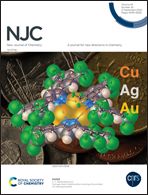Understanding the efficiency of ionic liquids–DMSO as solvents for carbohydrates: use of solvatochromic- and related physicochemical properties†
Abstract
The physical dissolution of carbohydrates (cellulose, chitin, and starch), i.e., without the formation of covalent bonds requires the solvent to possess certain physicochemical properties. Concentrating on cellulose, the solvent should act both as a Lewis acid and a Lewis base, and disrupt the present hydrophobic interactions, as the biopolymer exhibits amphiphilic characteristics. The quantification of the relative importance of these physicochemical properties helps in predicting the solvent structures, which are expected to be efficient as cellulose solvents. Ionic liquids (ILs) are extensively used as carbohydrate solvents because they disrupt the intramolecular-, intermolecular-, and hydrophobic interactions within the biopolymer structure, leading to its dissolution. Solvatochromic substances (probes) are especially sensitive to one or more of the above-mentioned biopolymer–solvent interactions. Consequently, they are used to predict and rationalize the solvent efficiency. The solvent parameters (descriptors) most widely employed are empirical polarity, ET(probe), Lewis acidity (SA); Lewis basicity (SB), dipolarity (SD), and polarizability (SP); S refers to the solvent. We synthesized 18 ILs, including derivatives of imidazole, 1,8-diazabicyclo[5.4.0]undec-7-ene, and tetramethylguanidine; the corresponding anions are carboxylates, chloride and dimethylphosphate. We used solvatochromic probes to calculate the descriptors of IL–DMSO (at fixed DMSO mole fraction of 0.6; 40 °C), and correlated ET(probe) with the other descriptors. We also tested the correlations by using a molar volume of the IL (VM) instead of SD, and the Lorentz–Lorenz refractive index function f(n) of the IL–DMSO mixture instead of SP. The quality of the regression analysis increased noticeably when we limited the ILs correlated with those based on imidazole (13 ILs), and used (VM) and f(n). The regression coefficients showed that SA is the most important descriptor; the solvent empirical polarity is inversely dependent on VM. The value of f(n) shows the importance of hydrophobic interactions. By using different probes, we showed that the observed small contribution of SB reflects the steric crowding around the positive nitrogen atoms in some probes. The results obtained help in selecting ILs as solvents for cellulose and other carbohydrates, based on the expected strength of their interactions with the biopolymers. Therefore, using solvatochromism for solvent efficiency screening saves labor and cost.



 Please wait while we load your content...
Please wait while we load your content...